In the 1920’s, Houdini wanted to write three books of magic for beginners. Each book would be dedicated to clearly demonstrating simple magic tricks that the reader could do. Magician Walter Gibson collaborated on the project.
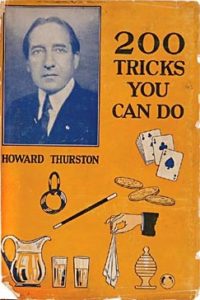 Gibson had just done research on such tricks for Howard Thurston for the ghost-written book 200 Tricks You Can Do and had literally hundreds of extra tricks as a result of his research: thus there would be no duplication in Houdini’s books.
Gibson had just done research on such tricks for Howard Thurston for the ghost-written book 200 Tricks You Can Do and had literally hundreds of extra tricks as a result of his research: thus there would be no duplication in Houdini’s books.
The first book was to be composed of simple card tricks that could be done with an ordinary pack. The second book was to contain tricks with special packs of cards. The third book was to cover simple tricks of various types. By early October, Gibson had the first book complete and was ready to deliver it when news came of Houdini’s sudden death in Detroit, on October 31, 1926.
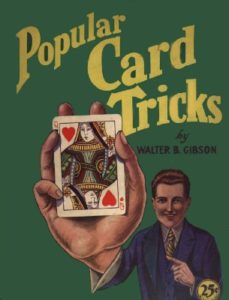 Later, the book was published by the E.I. Company under Gibson’s own name, with the title Popular Card Tricks. This forty-eight page book included 91 various card tricks with suggestion on presentation.
Later, the book was published by the E.I. Company under Gibson’s own name, with the title Popular Card Tricks. This forty-eight page book included 91 various card tricks with suggestion on presentation.
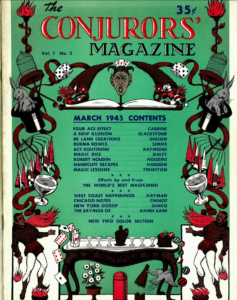 The material for the second was all outlined and twenty years later, Gibson wrote up many of the tricks for a series of articles in a revival of Houdini’s old Conjurer’s Magazine, which he edited, with Hardeen as Emeritus.
The material for the second was all outlined and twenty years later, Gibson wrote up many of the tricks for a series of articles in a revival of Houdini’s old Conjurer’s Magazine, which he edited, with Hardeen as Emeritus.
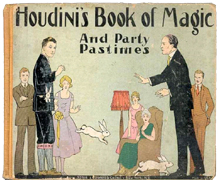 The third was published in 1927 by Houdini’s wife who found the manuscript among his papers. It was titled, Houdini’s Book of Magic And Party Pastimes.
The third was published in 1927 by Houdini’s wife who found the manuscript among his papers. It was titled, Houdini’s Book of Magic And Party Pastimes.
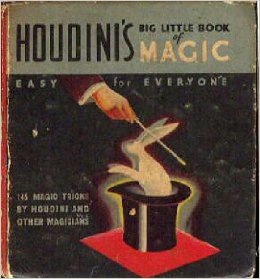 Later, another publisher, Whitman obtained rights to the manuscript in 1933 and arranged to print it in the Big Little Book (BLB) format but the material proved insufficient to fill the required number of pages. So, the first 114 pages are from the Houdini manuscript. The added tricks and puzzles are from other magicians. The BLB title page retains the original 1927 copyright date.
Later, another publisher, Whitman obtained rights to the manuscript in 1933 and arranged to print it in the Big Little Book (BLB) format but the material proved insufficient to fill the required number of pages. So, the first 114 pages are from the Houdini manuscript. The added tricks and puzzles are from other magicians. The BLB title page retains the original 1927 copyright date.
UPDATE:
 Published during the “Houdini renaissance” of 1976, there is also the paperback edition of Houdini’s Book of Magic with a great cover (above) and intro by Gibson in which he tells the story of how the book came to be. It also carries the 1927 copyright.
Published during the “Houdini renaissance” of 1976, there is also the paperback edition of Houdini’s Book of Magic with a great cover (above) and intro by Gibson in which he tells the story of how the book came to be. It also carries the 1927 copyright.
Source:
- eBay listing for Houdini Big Little Book of Magic
- The Great Houdini’s Book of Magic with Introduction by Walter B. Gibson [1976]
- Walter B. Gibson and the Shadow by Thomas J. Shimeld

Great job here, Joe. There is also the 1976 paperback edition of Houdini’s Book of Magic with a great cover and intro by Gibson. I can send a scan if you like.
Thanks John! I actually used and listed the 1976 paperback book as a source for this post and should have also included an image and description of the 1976 paperback. I have updated the post.
It seems Houdini, if I recall correctly, wanted to put together a “College Course of Magic”, etc. clearly Gibson would have been involved in that as well. Gibson would later write “The Mark Wilson Course of Magic”.
Could this be considered the course Houdini had planned in its later form?
Dorothy Dietrich and Dcik Broo0kz
The Houdini Museum
The Only Building in the World Dedicated to Houdini
According to Wikipedia, Publishers T. Grant Cooke and Walter A. Jordan developed an interest in producing a correspondence course in magic in the mid-1920s. A few months before his death, Harry Houdini was approached to author the course; Houdini declined but recommended Tarbell [hence Tarbell Course in Magic]. However, according to the comments on a related post Dean Carnegie did, this may not be true.
According to the Mark Wilson Course of Magic, the section on co-author Walter Gibson implies that Mark Wilson was planning a comprehensive magic course and met with Walter Gibson to discuss. They agreed that by combining the underlying principles of the past with vast array of present methods currently available, future effects could be developed on a grand and lavish scale. They cooperated to make the projected course the reality it is today.
According to Houdini for Kids, Houdini had many projects started, in the works, or at least on his mind. Houdini wanted to make the field of magic a real profession, creating the first college of magic in the world. He discussed the possibility with members of the Society of American Magicians (SAM), which he had founded. Student magicians could take classes, pass exams, and receive a degree in magic. Classes such as History of Magic, Psychology of Magic, and courses in advertising and showmanship would be offered. He dreamed that through such a course, “magic, as an art and science, will be elevated to a higher level.”